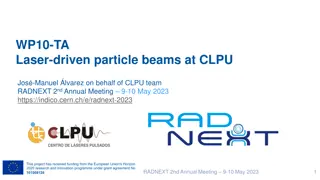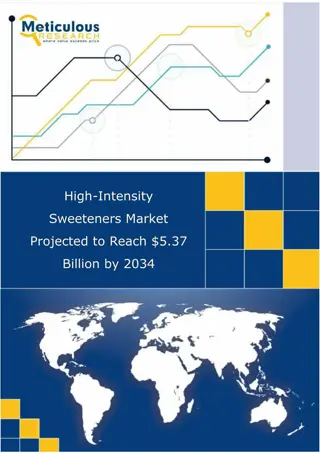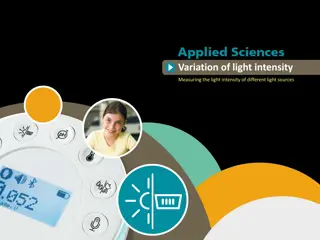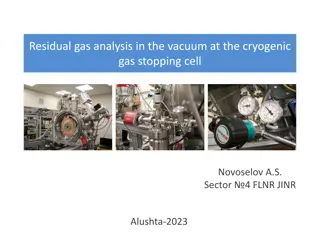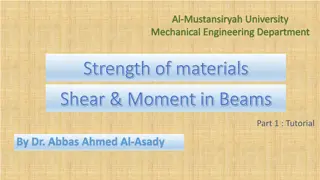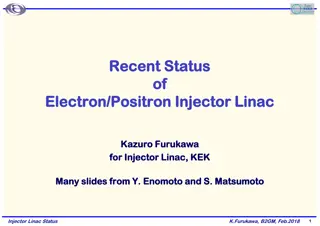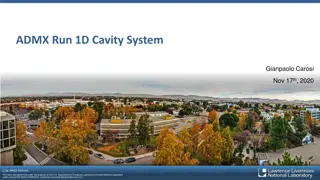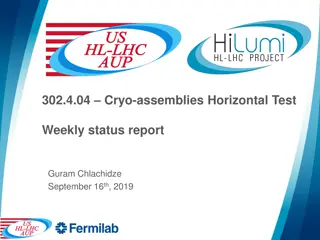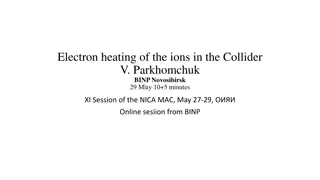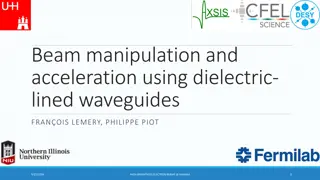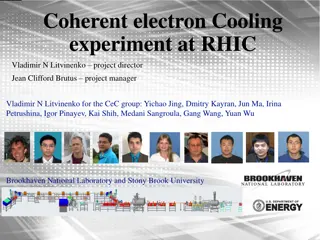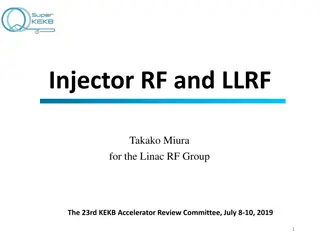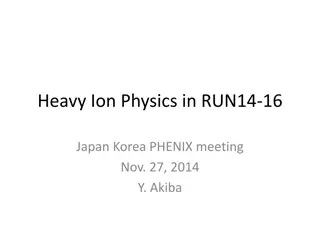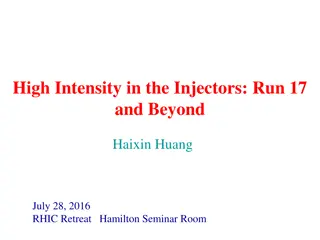RHIC RF system upgrades for high intensity beams
Delve into the upgrades and challenges faced by the RHIC RF system to accommodate high intensity beams, including discussions on new 9 MHz systems, downtime comparisons, Landau cavity issues, possible solutions using existing hardware, and system status challenges due to increased beam intensity. Discover how geometric phasing and rebucketing impact the system's performance.
Download Presentation

Please find below an Image/Link to download the presentation.
The content on the website is provided AS IS for your information and personal use only. It may not be sold, licensed, or shared on other websites without obtaining consent from the author.If you encounter any issues during the download, it is possible that the publisher has removed the file from their server.
You are allowed to download the files provided on this website for personal or commercial use, subject to the condition that they are used lawfully. All files are the property of their respective owners.
The content on the website is provided AS IS for your information and personal use only. It may not be sold, licensed, or shared on other websites without obtaining consent from the author.
E N D
Presentation Transcript
RHIC RF system upgrades for high intensity beams FY16 Retreat Alex Zaltsman July 2016
Topics RHIC RF Systems status and performance Acceleration systems and Landau cavities New 9 MHz system
RHIC RF downtime compare to the last ions run 197MHz and Landau downtime (hrs) 19.5 28.6 28 MHz downtime (hrs) 197MHz and Landau # of trips 28 MHz # of trips Run 14 Run 16 113 107 30 36 8.3 19.6
Landau Cavities Mentioned in almost all talks yesterday RF systems at C-AD Victims of own success! - Merges, merges, merges
Landau Cavity issues with higher beam intensities Beam Loading Beam current overpowers the cavity Over 400kV induced on the gap by the beam 10kV command from the LLRF 400kV 10kV July 28,2016 5
Possible solution using existing hardware: Existing configuration is critically coupled ( = 1) Rotating the drive loop will increase the coupling factor to a potential =6 of 6 coupling factor will potentially reduce the effect of the beam on the cavity by a factor of ~4 allowing us to run higher intensities The study is underway to figure out the feasibility and implementation strategies Another possibility would be to use one of the storage cavity as a Landau at different harmonic July 28,2016 6
RHIC RF System Status Challenges due to increased beam intensity Increased number of window comparator trips Due to beam loading Geometric phasing (phase between the cavity gap and beam position) becomes problematic at higher beam intensity Inconsistent rebucket leads to inconsistent geometric phasing - adjusting one affects other cavities July 28,2016 7
Tetrode Interaction at Rebucket Anode currents before and after rebucketing At rebucket, Storage cavities jump 3kHz onto the beam July 28,2016 8
Effect of geometric phasing of the storage system on operation with high intensity beams YS5 crowbar trip causing transient that brought down YS3 and YS4 on window comparator protection July 28,2016 9
Improving rebucketing and geometric phasing consistency Acceleration cavities do not regulate well at rebucketing Good 180 degree phase jump Bad 240 degree jump. July 28,2016 10
Impact on beam due to improper acceleration cavities phase jump Good rebucket jump at low intensity. Pulls beam from the center of the bucket. July 28,2016 11
Possible solutions for higher intensity issues: Storage system driver biasing Tighter tolerance in our re-bias technique of the solid state driver will result in less module trips during transient beam loading Improve low level rebucket machinery. FSS is sent on sabbatical to DR to work on it ... Modify accelerating system power amplifier might revisit cathode loading resistor value Request setup time with beam intensity increase Window comparator set-up Multidimensional tuner look-up table to restore cavities after fault. Beam Cavity temperature Cavity voltage Some of the problems could be alleviated by requesting more time to condition cavities (possibly on the down ramp. Investigating) July 28,2016 12
New 9 MHz RF System Design Requirements Physics Requirement: Longer Bunches - Reduce Space Charge. - Reduce Intrabeam Scattering Rates System Requirement: Operation Frequency Band 1 ( = 2.7 4.1) Operation Frequency Band 2 ( = 4.1 10.7) Total Required Gap Voltage per Ring Approximate Length per Cavity 8.72 - 9.1 MHz 9.1 - 9.34 MHz 160 3 KV m 13
Current Cavity Design Air The resulting gap capacitor assembly is the product of an ongoing collaboration between BNL and Comet Technologies. 14
Prototype Cavity Bell Housing Installed Internal Beam Pipe View 15
LeRHIC 9MHz Cavity Status Initial prototype cavity testing completed: Cavity has been high voltage tested in excess of 70kV CW between 8.71MHz - 10MHz. Dynamic tuning loop has been tested to have 40kHz range. - Low level tuning loop has been configured and tested. Calorimetry observations have confirmed expected losses for cavity, gap cap, and subassembly components. Suspected external corona discharge issue has been identified and remedied. Additional testing to be performed: HOM damping loop and circuit will be installed and tested. Fast feedback loop (and supporting components) will be installed and tested. 17
External Corona Discharge Summary Original Design - No corona ring or shielding electrodes * BNL suggested that shielding electrodes be included in the original design in anticipation of this high surface field. Peak Surface Field 3.9MV/m at 80kV Gap Voltage Current Design Includes Corona ring and shielding electrodes Peak Surface Field 1.25MV/m at 80kV Gap Voltage 18
LeRHIC 9MHz Cavity Operation Plans Install one cavity per ring during shutdown for testing with polarized protons. The cavity and RF system was not originally intended for use in this application; however, it could improve performance by providing a larger bucket area than our systems currently provide. - If needed, a shorting device will be available. Larger Bucket Area: - Improved ramping speed and voltage margin. - Lower beam loss during the energy ramp. - Improved emittance at top energy. - Traversing through resonances faster may improve final spin polarization. Install the remaining four cavities in preparation for low energy gold operations. 19
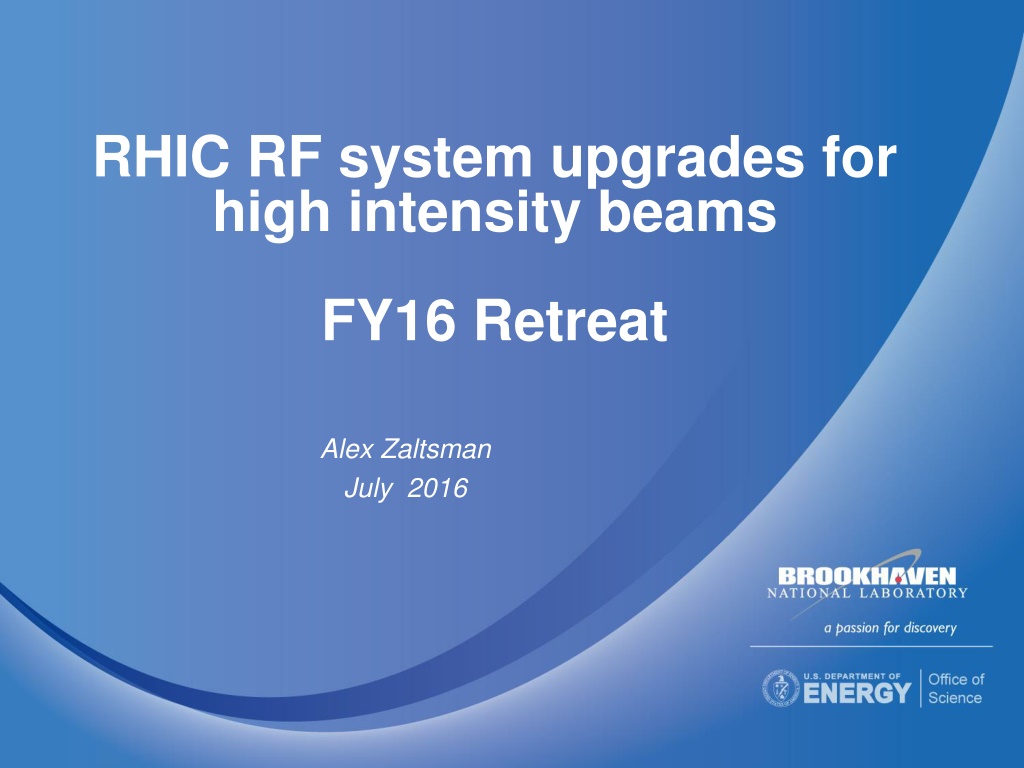
 undefined
undefined


